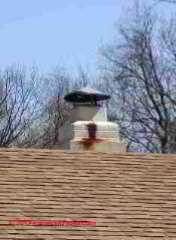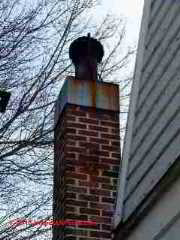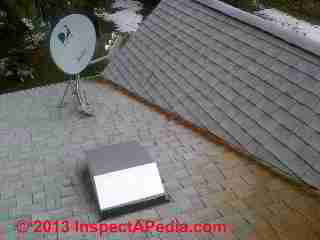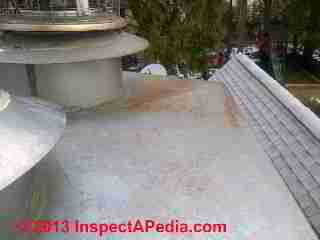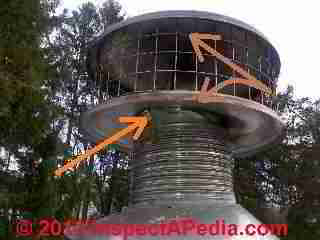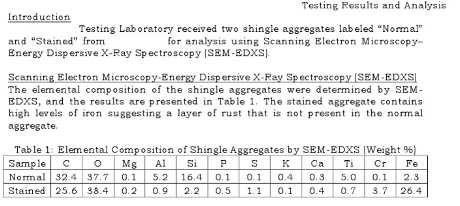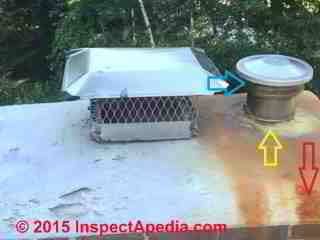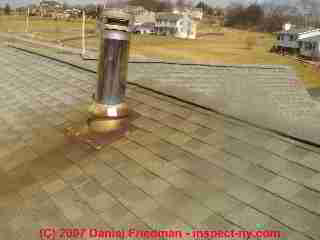 Guide to Red or Brown Rust Stains on Building Roofs & Chimneys
Guide to Red or Brown Rust Stains on Building Roofs & Chimneys
- POST a QUESTION or COMMENT about the causes of red or brown stains on roof surfaces or shingles
This article explains red or brown rust stains that occur on building roofs.
This article series tells readers how to identify & explain the most-common causes of black, brown, red, gray, green, or white stains appearing on roof shingles and on other building surfaces. Roof shingle stains are often caused by black algae, bleed-through or extractive bleeding of asphalt, dirt, soot, or organic debris.
InspectAPedia tolerates no conflicts of interest. We have no relationship with advertisers, products, or services discussed at this website.
- Daniel Friedman, Publisher/Editor/Author - See WHO ARE WE?
Rust Staining - Red or Brown Rust Stains on Asphalt Roof Shingles or on Metal Roof Surfaces
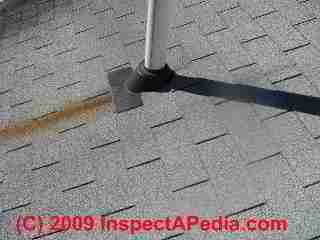
Metal roof flashings, metal chimneys, antenna mounts, or other metals that rust can stain roof surfaces a red or reddish brown color.
Expect to see rust stains only around and below rusting metal components on a roof.
If the rust staining is due to a deteriorated metal chimney, chimney cap, or roof flashing, further investigation is in order:
make sure that the chimney is safe (no holes) and that any rusted roof flashings are not leaking or about to leak into the building interior.
Otherwise this is a cosmetic defect which will be most noticeable on light colored shingles.
Red Rust Stains in Concentrated Locations Traced to Chimney Caps or Top Flashings
The dark red stain on the side of the chimney shown in the photograph of a New York home chimney shown below has its origin in the rusted galvanized metal chimney cap just above. Click to enlarge the photo and you'll observe a surprising detail: a comparatively small area of rust on the chimney cap can make a rather intense stain on surfaces below.
We figure that's because of the concentration of iron oxide dripping onto a specific and concentrated location.
In our second chimney top and cap rust stain photo (below) you can see another red rust stain spread pattern in the center of about five courses of brick below the very chimney top of this Maine home. Why does the stain appear about a foot below the metal chimney top cap rather than immediately below it?
Possible explanations have to do with the combination of the bent drip edge on the bottom of the chimney top flashing, wind direction, and even variations in brick porosity.
See CHIMNEY STAINS & LEAKS for other examples of red stains at or around chimneys or chimney rain caps, including red rust staining.
Red Stains over Roof Surface Traced to Chimney but is it Rust, Unsafe Chimney Flue, or Heater Operating Problems?
In a different case, the six photographs below show extensive red rust-colored roof staining covering a much wider area than the cases we discussed before. These pictures were sent to us by a chimney professional in Connecticut who asked:
I having a problem with a customer's chimney on Long Island, NY. We installed a oil burning boiler in 2006 with a stainless steel chimney liner. He has orange color staining on his stone chimney and roof shingles.
The top of the stone chimney is capped with stainless steel that seems to be rusting and it seems to be bleeding from there? Is it possible that the exhaust from our chimney is the cause? - W.R. Connecticut 2/20/2013
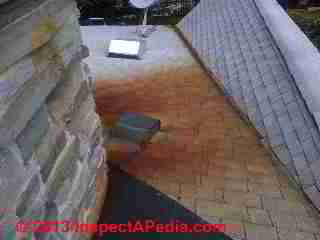
Note the broad area of rust-colored reddish-brown stains on the asphalt shingle roof (above left) and the extensive red-brown staining in the roof valley (below).
All of these stains are down-roof from the chimney. Discussing possible stain causes with Alan Carson, a home inspection professional & educator with Carson Dunlop Associates in Toronto we thought that the most likely explanation of the roof staining is rust from the chimney cap or top pan flashing shown at below left.
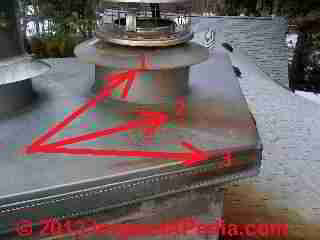
At above left notice the rusty edge of the drip collar just below the stainless steel chimney cap.
Note the rust stains that extend from the chimney top pan flashing below this collar and how the stains run to the top flashing edge (arrows). I think we can follow the rust down 1-2-3 to the edge of the pan flashing.
As with the earlier cases of red and rust stains on roofs it is surprising how much red iron oxide, sufficient to stain a wide area, can be generated by a relatively small area of rusting metal. Above right is another view of this area.
Follow the Rust Stains Up or Down the Roof between Suspected Source & Stain Locations
We also note in the photo at below left that red oxide is concentrated at the intersection of the base of the chimney and the rooftop where it appears that a roll-roofing or modified bitumen-covered cricket is installed. {We will eschew worrying about why we don't see any flashing, just caulking, at this location.
Remember that water (and iron-oxide bearing water) flows downhill. Usually. At below left our red arrows continue to follow the iron oxide down the chimney and down the cricket to the rusty area of the shingles below.
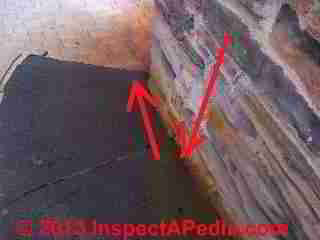
Check the Flue for Combustion or Heater Stain Particle Sources
Our photo at above illustrates the chimney cap - a stainless steel component. We didn't see anything red coming out of the flue (though we address that question in a moment) though we did see traces of soot or creosote (brown arrow) and what looks like some funny loose duct tape where we wouldn't expect to find that material (orange arrow).
This combination of visual evidence, and absent other details that might be disclosed from an onsite inspection, Al and I didn't think the red stains are coming up out of the flue (see discussion below) but rather are originating at the galvanized steel collar and possibly receiving a contribution from a rusting galvanized chimney top pan flashing.
Without an up-close inspection of the chimney pan flashing we don't know if the red there is just a deposit from above or if that component is rusting as well.
Follow-up comments and suggestions made another effort to rule out safety or mechanical system issues as follows. We considered these explanations for the red stains on the roof:
Editor Remarks:
First while there's no doubt about the metal chimney and its cap itself, I'm assuming you are certain that the chimney top crown/cover is stainless not galvanized (though even if it were poor quality SS or galvanized that would not explain the very large amount of red staining). Next: I have on occasion seen an oil burner producing red debris in an exhaust if
- the system is misadjusted and running quite hot (certainly we're seeing so little soot that this could be the case, though the next guess is the most interesting one)
- if this is a hydronic system (hot water boiler) or a steam boiler too if there is a water leak inside the boiler. Water dripping into the combustion chamber and cooking away in the exhaust can produce quite a bit of red debris.
Take a look into the combustion chamber of the boiler - look up at the underside of the heat exchanger for white crud, mineral deposits, stains, and also look at the combustion chamber liner and floor for signs of water or chamber liner damage. Let me know what you see at and inside the boiler.
It would make sense, just to assure the safety of the occupants, that you have the entire flue interior inspected using a ChimScan camera; you will assure the flue is safe, and further we might see deposits that shed more light on the red stains.
 Al Carson adds:
Al Carson adds:
- Rust seems logical. Products of combustion from an oil burner condensing? Possible but not usually without added circumstances like the water leak in the boiler you suggested.
- Is the chimney unusually tall or cold? Does it have 3 outside walls?
- Is there a contaminant in the combustion air? Chemicals in the basement? Anything corrosive in the environment of the boiler itself?
Our conclusion, supported by the close-up cropped from one of WR's photos [a good reason to take sharp high resolution photographs when diagnosing a building problem], is that the galvanized steel collar and chimney top pan are rusting.
Watch out: Of course, weaseling a bit, an on-site inspection is always orders of magnitude more reliable than sending photos by email. When you send photos to someone they are very helpful, even key. But the remote "expert" can only examine and comment on what you saw and photographed, not the other information, clues, or defects to which you never aimed eye nor camera.
That said, W.R. provided some excellent photos. Reader comments are welcome.
As we discuss at Power Washing Roofs we do not recommend roofing.
Reader Follow-Up: forensic lab test results of stained shingle area confirms FeO2 Iron Oxide in roof stains traced to a chimney cap
We sent a small piece of shingle and steel from that customer's roof and chimney cap to a lab in Georgia and this is the results of their findings.
[Click to enlarge any image]
Proving that the red stain is rust. Now we just have to find the source or sources of all this rust.
Yes some is coming from the stainless steel top but for all the rust that's running down his roof you would think that there would be nothing left of that top.
Reply:
Thanks for the report, it confirmed what we all thought. (Though there are some red algae that sometimes form stains on buildings, this report puts that worry to bed).
I started thinking at the same point I infer from your comment, that the amount of staining was just too huge to be blamed on that rusty stuff we see at the chimney top.
But having reviewed my library of rust stains on roofs I found other cases where there was dramatic staining traced to a relatively small (in square inches) area of rusting steel. I speculate that the number of molecules of FeO2 (iron oxide) needed to stick to and noticeably discolor a shingle or other surface, especially one that is good at capturing the FeO2 , is small - that is, a small amount of rusty water falling off of a chimney or flashing can produce a big area of staining.
Take a look again at the photos in the article we've done on this - in the article above. Some small areas of rust can produce a large stained area.
In sum, a small volume of rusting iron or steel can produce a large volume of water carrying staining iron oxide molecules that will adhere to different surfacesd at rates varying by the surface properties.
The second leg (I barely have one to stand on, I admit) is the tracing of the stain patterns uphill back to the probable source. Stains generally follow the water down the roof.
If there were a third leg (don't go there) it would be that previously in the same location as area of rust stain origin there had been other more badly rusted components at or around the chimney top that were replaced before you began. While you're at it, take another close look at that very orange-looking caulk I see in one of your photos at the base of the chimney.
The reason I do not suspect it is confirmed by your lab test - the test found iron oxide - we've then got to be looking for a source of FeO2 - back to flashings, current or prior. If you can find out prior history and if any parts were changed at the chimney top that would help.
If you take a look (or have someone else expert do so) at the heating appliance and its combustion chamber to finish closing the door on that (now looking unlikely) possibility that there was a heating system snafu, that'd leave us with just what's at the chimney top. I'd like to see you remove all of the galvanized at the chimney top, replace it all with stainless.
The next question is how much cleaning should be done on the shingles. Power washing shortens roof life; I've seen some try treatment with iron removers (IronOut) used on boilers and on plumbing fixtures - but watch out: if the cleaner runs down a building wall and is not washed off immediately we've created a new problem.
Chimney Stains May Indicate Unsafe Venting Conditions
A squashed chimney rain cap can also block the flue - see the photo of the round rain cap and flue in the photograph above.
See CHIMNEY RAIN CAP OPENING SIZE for an example of the trouble caused by a rain cover that does not provide adequate flue vent opening area.
Watch out: Stains around chimneys may indicate incomplete combustion and unsafe heating equipment or unsafe chimneys.
Red "rust" stains may not be actual oxide from rusting metal but rather a product of condensate from combustion gases forced down to close-by chimney or rooftop surfaces. In this case for oil fired equipment the stains may be from sulfur content of incompletely-burned fuel or from condenstate due to inadequate flue temperatures, perhaps mis-matched flue size and heater BTUh size.
See HEATING OIL TYPES & PROPERTIES for more about the types of oil fuels and their properties.
Red / Orange Roof Stains at Metal Chimneys: red dye in home heating oil red?
OPINION: On 2017-07-12 by Angelo Farruggia - Owner SAF Fire N' Stone, LLC - says red stains on roofs are from dye used in heating oil
While detailed the above inspector is completely incorrect.
The stains are on a boiler chimney. And I know without asking that it is an oil boiler. The oil used in home heating has been filled with red dyes over the years by the producers to discourage off road use.
The rust like staining is due to the dyes coming out at the top due. Liners that are not insulated as they should be by code, combined with the reduced turbulence of the liner will cause this to occur.
It is not rust.
An inverted cone cap to allow the residue to drip back in the flue can also help with this.
In cases of extreme staining your boiler should also be tuned to the lining system which should be done at installation. This has also become much more prevalent as the higher efficency units now being installed have a very low stack temp and high condensation effect.
On 2017-07-13 by (mod) re: source & chemisry of red stains on roofs around & below metal chimneys: sulfur or red dye in heating oil?
Thank you for the interesting comments, Angelo, but I have to respectfully disagree with you in several regards:
Most-often red roof stains around or below metal components or chimneys are rust, easily tracked to corroded metal components; you can see examples of rust stains in the photos and article above.
Sometimes roof stains around chimneys are indeed from ingredients in the exhaust from the chimney, particularly sulfates.
The forensic lab examination of samples reported in the RUST STAINS on ROOFS article above confirm that observation. Researching the effects of red dye in home heating oil we did not find any authority mentioning the appearance of those dye products in the rooftop chimney exhaust from oil fired heating appliances.
If the problem with stains on chimney flues were due to dye in the heating oil we ought to see those stains everywhere that heating oil is the fuel, or at least on all oil flues where there is condensation exiting the flue: we don't find that is the case.
Occasionally, as we note in the article above, we see roof stains from components of the exhaust from the chimney, usually where the heating appliance is improperly adjusted or not matched to the flue for proper venting. Those stains are normally soot (oil or gas, both cases very unsafe) or sulphur deposits (condensate, too-low flue temperatures).
In sum, corrosion and stains on and around metal chimneys include rust, flue gas deposits and corrosive condensates (though not primarily from oil dye as you suggest), rust stains from contact between dissimilar metals, occasionally sulfates (the main component) and even bacteria (in oil fired systems). But not from the marker dye used in home heating oil.
Corrosion on metal flues is seen because of
- Use of connectors, strapping, that are not stainless
- Acidic corrosion of condensate on metal chimney parts, particularly where the chimney temperatures are indadequate for any reason or where an occupant is burning wet or sappy firewood (the problem is not restricted to oil fuel)
- Inadequate draft - such as the rust-red stains below the chimney above that vents a gas-fired heater; insufficient draft can be caused by a variety of snafus including
-- high sulfates in the fuel - see Kraloveskl cited below
-- not enough combustion air
-- wrong flue size or height for the heating appliance(s) and the total BTUh vented into the flue
-- wrong chimney type
-- improper or missing chimney cap
-- site features and shapes such as downdrafts, obstructions
Tune the boiler to the chimney?
I agree with you that for many installations an insulated flue is needed though for gas appliances generally a B-vent that is multi wall but not actually insulated is approved and proper.
But I'm not sure what specific suggestions can be offered about tuning a boiler to the chimney; generally we think the chimney has to be selected for the boiler. A boiler or furnace needs to be set to adequate draft and temperature, based on measurements made in the breech and over the fire at the heater.
On some installations the tech or chimney expert may opt for a forced draft or draft booster fan - perhaps that's an example of tuning the heating system to a flue that otherwise doesn't vent properly.
I agree that directing condensate to a less harmful location - such as the drip control you suggest - makes plenty of sense, but if I had a chimney with a lot of condensate I'd want to know that the whole combustion system is working safely. Particularly with inadequately fired or vented gas fired equipment the risk is production of fatal carbon monoxide gas in the building.
More details
GAS BURNER FLAME & NOISE DEFECTS - Watch out: sooting from gas fired heating equipment is very dangerous risking fatal carbon monoxide poisoning
OIL BURNER SOOT & PUFFBACKS - Watch out: severe sooting or smoking from oil fired heating equipment risks a dangerous puffback explosion
Dyes used in oil fuels
- U.S. low-tax fuels, high-sulfur fuels (note the "high sulfur" regarding the stain discussion below) are dyed with Solvent Red 26 3.9lbs per 1000 barrels, or Solvent Red 164
- Europe, rebated fuels are dyed with Solvent Yellow 124 ("Euromarker")
- Worldwide, aviation gasoline is dyed according to its type: Aviation gasoline 80/87 has red dye while Aviation gasoline 82UL is coloured by a purple dye
In some cases dyes may indeed have an effect on oil or diesel fuels but our research did not find reports that red dye in heating oil shows up at chimney tops.
Research on Corrosion of Metal Chimneys & Flues & Impact of Red Dye in Heating Oil
- See HEATING OIL TYPES & PROPERTIES for details.
- Moses, C. A. The Evaluation of Red-Dye Contamination in Jet Fuel and the Identification of a Screening Method for Thermal Stability Issues. FAA Report DOT/FAA/AR-10/15, 2010.
- Konzo, Seichi, James T. Lendrum, Keith Harry Hinchcliff, and Warren Skinner Harris. "Chimneys and Fireplaces." University of Illinois Bulletin Vol. 043, No. 017, Nov. 3 1945 (1945). - old but good
- Schulz, J. F. "Prefabricated Chimneys." In Proceedings of 1966 National Incinerator Conference. 1966.
- Bordzilowski, J., and K. Darowicki. "Anti-corrosion protection of chimneys and flue gas ducts." Anti-Corrosion Methods and Materials 45, no. 6 (1998): 388-396. [Industrial but informative]
Industrial chimneys are a great part of environmental protection in industrial countries. In recent years many of them have been used to carrying away very aggressive gases from boilers and flue gas desulphurisation (FGD) units below acid dew‐point temperature.
It is very important to modernize the old stacks and protect them against corrosion. The proper anti‐corrosion protection of modern high stacks is also an important technical and economical problem. In this paper the mechanism of acid dew‐point corrosion, as well as construction of industrial chimneys, methods of their anti‐corrosion protection and modernisation are described. - Shreir, Lionel Louis, ed. Corrosion: corrosion control. Newnes, 2013.
- Kucera, Vladimir. "Influence of acid deposition on atmospheric corrosion of metals: A review." 1986.
- Audouard, Jean Pierre, Michel Verneau, and John M. Grocki. "Corrosion performance and field experience with super duplex and super austenitic stainless steels in FGD systems." In CORROSION 2000. NACE International, 2000.
- Kraloveskl, Richard F. "OIL HEAT VENTING GUIDELINES-VENT MATERIALS AND CORROSION." Brookhaven National Lab, (1993)
Questions & answers about stains on roofs traced to chimneys or chimney components given below were posted originally
On 2015-07-17 by (mod) re: diagnosing red rust color & yellow circle of stain around the chimney top
Tom you can use the page bottom CONTACT link to find an email to send us photos for comment.
Look closely at the chimney top. If the stains are from corroding metal then it may need replacement with a better grade material.
If the stains are from deposits left by flue gases then it's possible that the heating system is not properly tuned and adjusted. Typically a properly tuned oil fired heating system runs with just a trace of smoke in the exhaust - it should not be leaving coloured deposits.
On 2015-07-14 by Tom
We replaced our chimney crown a year ago and had the chimney company seal it with crown seal. There is a fireplace flue (unused) and a oil furnace flue.
There is a red rust color coming from the area of the oil flue and cap as well as what appears to be a small circle of yellow substance surrounding the SS flue pipe.
The chimney sealant has now peeled leaving a real mess. Photos are available if you need them If you have any ideas on what is causing this that would be great.
...
Continue reading at SOOT STAINS on ROOFS or select a topic from the closely-related articles below, or see the complete ARTICLE INDEX.
Or see these
Recommended Articles
- RED STAINS on BRICK - RUST?
- STAIN DIAGNOSIS on ROOFS - home
- STAINS on / near CHIMNEYS related to leaks
- CHIMNEY INSPECTION DIAGNOSIS REPAIR - home
Suggested citation for this web page
RUST STAINS on ROOFS at InspectApedia.com - online encyclopedia of building & environmental inspection, testing, diagnosis, repair, & problem prevention advice.
Or see this
INDEX to RELATED ARTICLES: ARTICLE INDEX to BUILDING ROOFING
Or use the SEARCH BOX found below to Ask a Question or Search InspectApedia
or see
INDEX to RELATED ARTICLES: ARTICLE INDEX to CHIMNEYS & FLUES
Or use the SEARCH BOX found below to Ask a Question or Search InspectApedia
or see
INDEX to RELATED ARTICLES: ARTICLE INDEX to BUILDING STAINS
Or use the SEARCH BOX found below to Ask a Question or Search InspectApedia
Ask a Question or Search InspectApedia
Try the search box just below, or if you prefer, post a question or comment in the Comments box below and we will respond promptly.
Search the InspectApedia website
Note: appearance of your Comment below may be delayed: if your comment contains an image, photograph, web link, or text that looks to the software as if it might be a web link, your posting will appear after it has been approved by a moderator. Apologies for the delay.
Only one image can be added per comment but you can post as many comments, and therefore images, as you like.
You will not receive a notification when a response to your question has been posted.
Please bookmark this page to make it easy for you to check back for our response.
IF above you see "Comment Form is loading comments..." then COMMENT BOX - countable.ca / bawkbox.com IS NOT WORKING.
In any case you are welcome to send an email directly to us at InspectApedia.com at editor@inspectApedia.com
We'll reply to you directly. Please help us help you by noting, in your email, the URL of the InspectApedia page where you wanted to comment.
Citations & References
In addition to any citations in the article above, a full list is available on request.
- Roger Hankey is principal of Hankey and Brown Inspections, Winter Park, CO. Mr. Hankey is a past chairman of the ASHI Standards Committee and served in other ASHI chapter and national leadership roles. Mr. Hankey is a National Radon Proficiency Program certified measurement professional and a Level II infrared thermographer. Contact Roger Hankey at: 970-393-6604 - rogerhankey47@gmail.com . Website: www.HankeyandBrown.com Mr. Hankey is a frequent contributor to InspectAPedia.com.
- Asphalt Roofing Residential Manual from ARMA the Asphalt Roofing Manufacturers Association Website https://www.asphaltroofing.org/product/residential-asphalt-roofing-manual/ ,
- Building Pathology, Deterioration, Diagnostics, and Intervention, Samuel Y. Harris, P.E., AIA, Esq., ISBN 0-471-33172-4, John Wiley & Sons, 2001 [General building science-DF] ISBN-10: 0471331724 ISBN-13: 978-0471331728
- Building Pathology: Principles and Practice, David Watt, Wiley-Blackwell; 2 edition (March 7, 2008) ISBN-10: 1405161035 ISBN-13: 978-1405161039
- In addition to citations & references found in this article, see the research citations given at the end of the related articles found at our suggested
CONTINUE READING or RECOMMENDED ARTICLES.
- Carson, Dunlop & Associates Ltd., 120 Carlton Street Suite 407, Toronto ON M5A 4K2. Tel: (416) 964-9415 1-800-268-7070 Email: info@carsondunlop.com. Alan Carson is a past president of ASHI, the American Society of Home Inspectors.
Thanks to Alan Carson and Bob Dunlop, for permission for InspectAPedia to use text excerpts from The HOME REFERENCE BOOK - the Encyclopedia of Homes and to use illustrations from The ILLUSTRATED HOME .
Carson Dunlop Associates provides extensive home inspection education and report writing material. In gratitude we provide links to tsome Carson Dunlop Associates products and services.


